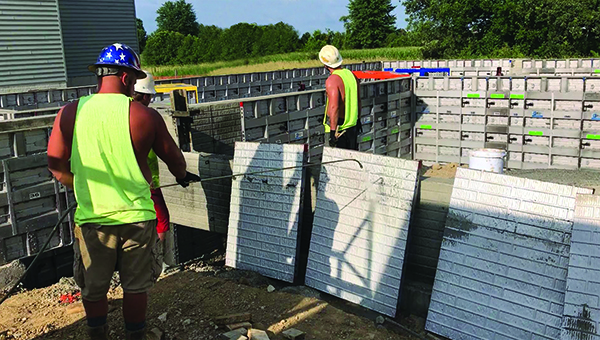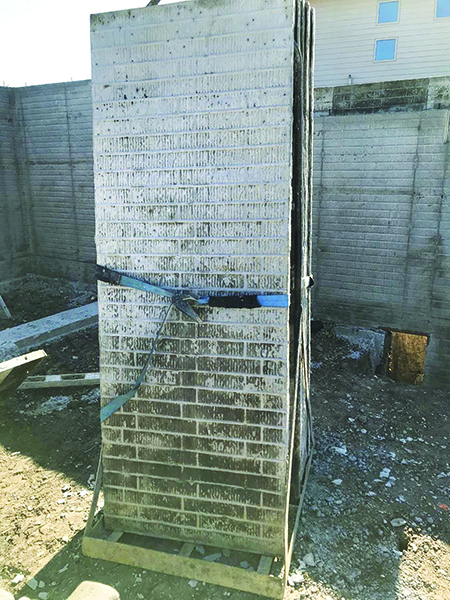Matching Form Release Agents to Application Methods: Part II
TECHNICAL DEPARTMENT:
Matching Form Release Agents to Application Methods
Part 2 of a 4-Part Series
By Destry Kenning, Forming Market Segment Manager, Nox-Crete Products Group
Formwork requires a considerable investment, but even the best forms cannot produce the best results unless they are paired with the proper form release agent. To prevent the adhesion of concrete on the face of forms, application of a form release agent is necessary. Additionally, a form release agent protects formwork, increases long-term durability and helps produce smooth, stain-free concrete surfaces with fewer defects.
There are many types of form release agents, and they have qualities that make them anything from good enough to great. A good release agent will allow the form panel to strip with little effort. A great release agent will make stripping the forms easy, keep the forms clean, extend the useable life of the forms, and be safe for workers and the environment. There are many factors, however, that come into play when bringing a release agent from good to great.
Choosing a great release agent is about so much more than knowing which stand-alone product is best. How it is used, when it is used, what it is used on and the method of application preferred by the crew must all be taken into account in order to choose the most practical and economical product for the job. This is easier said than done, when you consider the huge variety of form release agents currently available.
 Options Abound
Options Abound
The good news about form release agents: There are many options. The bad news: There are many options, and this can make narrowing down to the right one more difficult. There are water-based and oil-based carriers, and that is just the beginning. Knowing exactly what is in the release agent is also important. For example, some oil-based release agents contain potentially hazardous recycled transformer oils. Used or recycled oils can contain harmful, and even carcinogenic, compounds that did not exist in the original virgin oil. Generally, water-based release agents require mixing, are susceptible to freezing and are more difficult to see on the form once the water evaporates. For these reasons water-based release agents are rarely used at the residential level.
In addition to the formulation base, release agents fall into the two basic categories of barrier and reactive, and the to kinds are not equally suited for every form substrate. As their names imply, barrier release agents create a physical barrier between the form surface and the concrete, and reactive release agents contain an ingredient that reacts with lime in the fresh concrete. Numerous formulas of form release agents are currently available in combinations of water or oil carriers with barrier, reactive, or a combination of barrier and reactive components.
The Right Formula for the Form
The form material on which the form release agent is applied is another factor in choosing the right product. One release agent might be good for aluminum forms but would not work so well on overlaid plywood — so it is important to know how each formula works. In the words of M.K. Hurd, the Concrete Construction editor and engineering pioneer: “Many form oils and other release agents adequately prevent sticking, but using the correct type of release agent for the form material can do much more. The right release agent properly applied can minimize color variations, staining, bugholes (blowholes), and poor form-surface durability. A good release agent should also be easy to apply evenly at the recommended coverage and should help to maximize form reuse.”
In other words, any release agent may get the job done, but the right release agent will achieve better results in the most economical way. After a large investment in forms and labor, why chance a high-quality outcome on a low-quality form release agent, or a release agent that just is not right for the job?
 Best Practice vs. Common Practice
Best Practice vs. Common Practice
In an ideal world, a form release agent is sprayed onto the form prior to being set. The spray-before-set method works great when forms have no buildup. However, buildup is common, especially on aluminum forms, and it is best to apply a reactive/barrier release agent when the form is stripped. Otherwise, the buildup will continue to gain strength, likely leading to more buildup, and making it more difficult to remove later. Even old buildup on aluminum forms will soften with repeated use of a reactive release agent. Applying a reactive release agent immediately after stripping the forms gives the product more time to penetrate and soften buildup. On overlaid plywood forms, applying the release agent after stripping the forms will help retain moisture in the plywood, which reduces cracking that occurs when the panel dries rapidly and the wood fibers contract. This is especially important if forms are left out in the sun, as they often are while in use or in storage. On the whole, the spray-before-set or spray-after-strip methods will give you better results and will result in less form damage and less damage to the concrete surface.
These two methods may be best practice, but we all know there is often a big difference between the ideal way of doing things and the way they are actually done. At CFA’s Concrete Foundations Convention 2017 in Nashville, contractors were polled with this question: “How do you spray your forms?” Contractors could choose from three possible application methods: (1) spray before set, (2) top down, (3) spray after strip.
Most contractors said the “top down” application was most commonly used by their workers. When asked why workers preferred the top down method, contractors said it was to prevent having to handle a form that has been oiled. Workers who move oiled forms end up covered in the release agent they sprayed, which frequently contains reclaimed or unpleasant — and potentially hazardous — components. To avoid this, they walk the wall and spray the already-in-place forms from the top down. Again, workers prefer this method because they get less oil on themselves.
Here is where the real problems start. In order to be effective, the entire form must be coated with release agent. If the form exterior does not get evenly covered with release agent, it will develop buildup and could be damaged in the stripping process. Some applicators are aware of this, so when they apply a release agent using the top down method, they continue to spray release agent until they see it running out on the footing. This is a wasteful strategy, and it typically leads to inconsistent results, especially during colder weather conditions when release agent viscosities increase.
If contractors insist on top down application, then they should at least select the release agent best suited for this application method. For top down applications, a low viscosity release agent is crucial, especially in cold conditions. A low viscosity formulation is easier to spray and can be applied in thin, even coats, reducing excess runoff.
Finally, consider the labor required to apply the form release agent. Hurd points out, “The agent’s ease of application is also important, since the labor needed to apply the material costs more than the material itself.” Laborious time spent scraping and trying to get forms cleaned can be mostly reduced by proper application before setting or after stripping, and by making an educated decision on which release agent works best for your forms.
The Cost of the Wrong Release Agent
Keep in mind that choosing an economical release agent does not always mean saving money overall. As Hurd states, “The cost of using a release agent is small in comparison to formwork costs. Therefore, omitting or selecting a release agent based on price alone is false economy, especially since using the right release agent can extend a form’s service life.” Well-maintained forms combined with the proper release agent will result in maximum reuse. The right release agent will reduce concrete buildup, improve the cast concrete appearance, and reduce damage such as that caused by pry bars when forms stick.
Another way the wrong release agent can increase your costs is in fines for non-compliance. It is important to be in compliance with federal, state and provincial volatile organic compound (VOC) regulations, which protect against air pollution. The federal limit for VOCs in a release agent is 450 grams per liter. This means that diluting a release agent with a carrier such as diesel fuel or kerosene at a one-to-one rate will exceed the federal regulation and is subject to a fine of anywhere from $100 to $50,000 per violation per day. The VOC regulations and related fines for non-compliance can vary from state to state, so be certain to rule out non-compliant options from the start.
When it comes time to choose the best release agent for the job, carefully consider the form release agent composition and the method of application. A low quality release agent or any improperly applied release agent has the potential to stain or damage resulting concrete surfaces and can potentially damage the forms. In the end the best release agent will be easy to apply, safe to use, and will be compliant with VOC regulations in your area. It will also provide a combination of good economy, good concrete appearance, and the lowest form maintenance costs for your specific requirements.
Works Cited: Hurd, M.K. “Choosing and Using a Form Release Agent.” Concrete Construction, 1 Oct. 1996.







